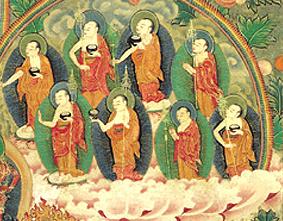Arhat: Difference between revisions
Jump to navigation
Jump to search
mNo edit summary |
No edit summary |
||
| Line 3: | Line 3: | ||
==Subdivisions== | ==Subdivisions== | ||
There are two kinds of arhat: those with remainder and those without remainder. | There are two kinds of arhat: those with remainder and those without remainder. | ||
==How an Arhat teaches== | |||
Arhats teach by means of the [[three pure factors]] (Tib. དག་པ་གསུམ་, Wyl. ''dag pa gsum'') <ref>[[Patrul Rinpoche]], ''Preliminary Points To be Explained when Teaching the Buddha's Word or the Treatises'', translated by Adam Pearcey.</ref> | |||
==References== | |||
<small><references/></small> | |||
==Internal Links== | ==Internal Links== | ||
Revision as of 08:12, 8 June 2011

Arhat (Skt. arhat; Tib. དགྲ་བཅོམ་པ་, drachompa; Wyl. dgra bcom pa) — the ultimate result of the shravaka yana and pratyekabuddha yana. One who has completely overcome the enemy of the disturbing emotions and is therefore worthy of praise.
Subdivisions
There are two kinds of arhat: those with remainder and those without remainder.
How an Arhat teaches
Arhats teach by means of the three pure factors (Tib. དག་པ་གསུམ་, Wyl. dag pa gsum) [1]
References
- ↑ Patrul Rinpoche, Preliminary Points To be Explained when Teaching the Buddha's Word or the Treatises, translated by Adam Pearcey.